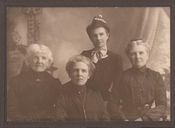The Dibble Family
Story by Gail J. McCormick, "The Pioneers" (edited to focus only on the family, not the house)
The Dibbles crossed the Oregon Trail in 1852. Traveling along with Horace and Julia Ann Sturges Dibble were their three children: Eliza Emily, 6; Fayette, 4 and Roswell, babe in arms. The journey, known for its difficulty, was especially hard on the Dibbles. On the trip, Eliza was bitten on the leg by a rattlesnake. Her leg never grew properly and it always prevented her from walking and running normally. Upon their arrival in Oregon, the Dibbles initially settled in the Needy area. One day, Horace took a ride to look for lost cattle. His quest led him south of the Four Corners where he came upon a little knoll.
Horace immediately fell in love with the spot and wanted it for a homesite. He inquired as to who owned the property. After finding the owner to be Rachel Larkins, he bought the land and planned the building of a home. The year was 1854. Now, since carpenters were much in demand at the time and money was scare, Horace offered a carpenter 320 acres of land to build his home. It was built in the saltbox style, common in New England, but rarely seen in Oregon. Built of fir and cedar, the house is sturdy and well constructed. It has two stories and contains more windows than the average dwelling. As of the time, the fir floors were placed using square nails and the thresholds are several inches lower than the floors because of the many footsteps that have crossed over them through the years.
INDIANS LOVED APPLES
The Dibbles planted apple trees, some still producing today. In the mid-1800's a small orchard was a real treat, and as the fruit matured and ripened, settlers and Indians alike came to buy apples. Excess apples were stored on shelves in the cellar and the late Ina Dibble related an amusing story about the apples. It seems that Beaver Trapper and other Molala Indians came in the spring for apples. Horace Dibble told them he had apples left in the cellar, but they were soft and some spoiled. The Indians' idea of a good apple was not the same as the pioneers. They took the apples and munched with gusto, happily leaving far with gunny sacks of apples tossed over their backs.
LATER YEARS
The Dibble story ends happily. For many, many years, the Dibbles were part of the Molalla community. They had five more children: Thomas Leroy, Maria Sylvinia, Jesse Morton, Annie Florinda and Walter Perry. Eliza went on the marry A.J. Sawtell, the teasel farmer, and became an expert seamstress. Roswell went on to marry Jett Milster from Silverton. For many years they lived on Warrick Road near Molalla.
Thomas Dibble married Marian Long and bought land near Russellville. He was a farmer and logger. They had two children, Guy and Ina. They were well-know locally as a musical family. The Dibble Orchestra played for many local celebrations. Ina is fondly remembered by old-timers in the Molalla area. She never married after losing her sweetheart to World War I.
A small twig table in a heart-shape design, given to Ina by her sweetheart, is on display at the Dibble House. For years, Ina lived alone, but claimed to never be lonely. She had a simple life and her special love was music. She played the dulcimer for all who would listen. Maria married twice--to William H. Lews and Arthur Kayler. Annie married John K. Wilson and moved the Molalla area.
Walter lived with his mother until her death and then moved from the Molalla area. Fayette died when he was 20.
Ina is fondly remembered by old-timers in the Molalla area. For years, Ina lived alone, but claimed to never be lonely. She had a simple life and her special love was music. She played the dulcimer for all who would listen. Guy married Mary Agnes Mulhilville; they had no children.
Jesse died in 1863 at the age of 4, and was buried in the Dibble-Larkins-Jackson-Austin Cemetery.
Maria married twice--to William H. Lewis and Arthur Kayler. She had two sons, Mark Twain Lewis and Rex Wayne Lewis. She died of an accidental drowning in 1902, and was buried in the Molalla Memorial Cemetery.
Amy married John K. Wilson and moved from the Molalla area. She had two daughters, Edna and Winnie. She lived in Portland later in life, and her brother Walter lived with her for a time.
Walter lived with his mother until her death in 1904 and then moved from the Molalla area. He never married.
After Julia Dibble’s death in 1904, the house was sold to Dudley C Boyles and his wife, Goldie Miller Boyles. Dudley was a real estate agent and his work kept him busy. They had two daughters, Aileen and Marian. In 1914 Dudley was elected County Recorder and the family moved to Oregon City. They kept ownership of the house and rented it out. They were living in Hot Lake, Union, Oregon by 1920, where Dudley served as a Postal Clerk for the Sanitarium there. He died after a car accident in 1930 while on a family camping trip in Idaho, and was buried in the Russelville Cemetery. Goldie and her daughters lived in LaGrande through the years of the Great Depression, after which Goldie was able to return to Molalla , where she lived in the Dibble house until her death in 1968.

















